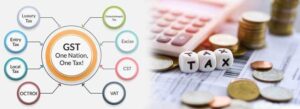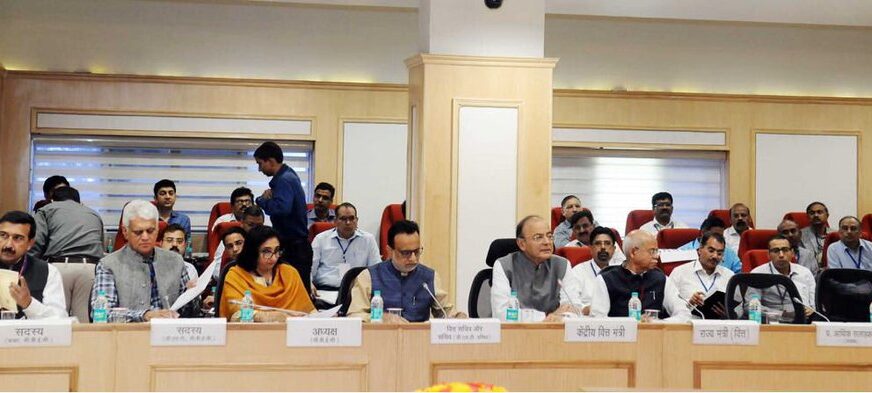GST, CGST AND MISCONCEPTIONS
DISCUSSION WITH REFERENCE TO INDIA
ANSWER TO OXFAM REPORT PUBLISHED
SARASIJ MAJUMDER, Chartered Engineer

ENS ECONOMIC BUREAU, @ NEW DELHI published a biased article which is based on a report. Content of that report can be summed up as “MASTERBATION OF ECONOMICS AND TAXATION”. The report was published by OXFAM.
Using this as weapon, some ‘DIMWITS’ of our country are trying to deride Modi, and BJP government on implementation of “GST”.
One of my collegemate, however, lambasted this Malafide report with sound reasoning—but he posted that in a social group having very limited readers.
I observed that the subject publication of ‘ECONOMIC BUREAU’ is doing rounds in social circuits, and may be influencing the people not well versed with the subject.
Hence, I wrote this BLOG and posted to place the subject in proper perspective.
Goods and services tax should not be confused with The Generation-Skipping Trust, also abbreviated as GST (and its related taxation, GSTT).
The goods and services tax (GST) is a value-added tax (VAT) levied on most goods and services sold for domestic consumption. The GST is paid by CONSUMERS, but it is remitted to the government by the Businesses Selling The Goods And Services.
Critics point out, however, that the GST may disproportionately burden people whose Self-Reported income are in the lowest and lower-middle income brackets, making it a regressive tax. These critics argue that GST can therefore exacerbate income inequality and contribute to social and economic disparities.
In order to address these above concerns, and reduce the impact, INDIA has introduced GST exemptions or reduced GST rates on essential goods and services, such as food and healthcare, mostly consumed by LIG.
KEY POINTS:
- The goods and services tax (GST) is a tax on goods and services sold domestically for consumption. Hence it is a tax paid by consumers.
- The tax is included in the final price and paid by consumers at point of sale (POS) and CREDITED to the government by the seller.
- The GST is usually taxed at a single rate across a nation.
- Governments prefer GST as it simplifies the taxation system and reduces tax avoidance.
- Critics of GST say it burdens lower income earners more than higher income earners. Correct, as people in lower income bracket spends most on ‘Consumption’, rather than savings, and investment.
- But those fault finders must notice that GST for Luxury items are quite high, rather highest.
One must understand that free supply of food grains, with subsidized cooking gas offset this burden mostly to people of very low income groups!
Somebody else MAY have paid GST/CGST at some stage on these free issued products for them.
HISTORICAL BACKGROUND:
France was the first country to implement the GST in 1954; since then, an estimated 140 countries have adopted this tax system in some form or another.
Some of the well to do countries with GST include Canada, Vietnam, Australia, Singapore, United Kingdom, Spain, Italy, Nigeria, Brazil, and India.
Only a handful of countries, such as Canada and Brazil, have a dual GST structure.
Compared to a unified GST economy where tax is collected by the federal government and then distributed to the states, in a dual system, the federal GST is applied in addition to a local sales tax. In Canada, for example, the federal government levies a 5% tax and some provinces also levy a provincial sales tax (PST), which varies from 8% to 10%. In this case, a consumer’s receipt will clearly have the GST and PST rate that was applied to their purchase value.
More recently, the GST and PST have been combined in some provinces into a single tax known as the Harmonized Sales Tax (HST). Prince Edward Island was the first to adopt the HST in 2013, combining its federal and provincial sales taxes into a single tax. Since then, several other provinces have followed suit, including New Brunswick, Newfoundland and Labrador, Nova Scotia, and Ontario.
Critiques of the GST
GST is wrongly defined as a regressive tax, meaning that it takes a relatively larger percentage of income from lower-income households compared to higher-income households. This is because GST is levied uniformly on the consumption of goods and services, rather than on income or wealth.
Please understand, a Rs.10/- Tax, from a person earning Rs. 100/- is 10%, but from a person earning Rs. 1000/- is 1%. And in any society or country—number of people in Low Income Group is much more than that number of Wealthy people.
Lower income households tend to spend a larger proportion of their income on consumables, such as food and household goods, which are subject to GST. As a result, total GST collected, is largely contributed by lower income households.
Because of this some countries with GST have considered possible adjustments that could make the tax more progressive by taking a larger percentage of TAX from consumables meant for, and purchased by higher-income earners.
India’s Adoption of the GST:
- India established a dual GST structure in 2017, which was the biggest reform in the country’s tax structure since indolence. Congress Government discussed, and debated about it, but never had the courage to implement this reformation.
- The main objective of incorporating the GST was to eliminate tax on tax, or double taxation, which cascades from the manufacturing level to the consumption level.
India has, since launching the GST on July 1, 2017, implemented the following tax rates:
- A 0% tax rate applied to certain foods, books, newspapers, homespun cotton cloth, and hotel services.
- A rate of 0.25% applied to cut and semi-polished stones.
- A 5% tax on household necessities such as sugar, spices, tea, and coffee.
- A 12% tax on computers and processed food.
- An 18% tax on hair oil, toothpaste, soap, and industrial intermediaries.
- The final bracket, taxing goods at 28%, applies to luxury products, including refrigerators, ceramic tiles, cigarettes, cars, and motorcycles.
The previous system, with no GST, implied that tax was paid on the value of goods and margin at every stage of the production process. This would translate to a higher amount of total taxes paid, which was then carried down to the end consumer in the form of higher costs for goods and services. The implementation of the GST system in India was, therefore, a measure that was used to reduce inflation in the long run.
Who Has to Pay GST?
In general, goods and services tax (GST) is paid by the consumers or buyers of goods or services. Some products, such as from the agricultural or healthcare sectors, may be exempt from GST depending on the jurisdiction.
How Is GST Calculated?
The goods and services tax (GST) is computed by simply multiplying the price of a good or service by the GST tax rate. For instance, if the GST is 5%, a Rs.1.00/- candy bar would cost Rs.1.05/-.
What Are the Benefits of the GST?
The GST can be beneficial as it simplifies taxation, reducing several different taxes into one straightforward system. It also cut down on tax avoidance among businesses and reduces corruption.
I boldly conclude that an average educated person have welcomed “GST”—unless he is paid to spread misinformation with Malafide intention.
REFERENCES: –
- 1.0 Ernst & Young. “Worldwide VAT, GST and Sales Tax Guide 2022: France,” ” Pages: Preface, 238-241, 296-298, 595, 748, 752-753.”
- Government of India: Press Information Bureau. “Frequently Asked Questions (FAQs) on Goods and Services Tax (GST).”










